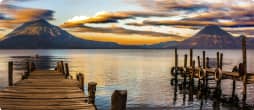A small Central American country with a huge Maya legacy, Guatemala is a bucket-list travel destination which encompasses biodiverse rainforests, volcanoes, highland lakes, beaches, and mysterious jungle ruins. Travelers often choose a tour of Guatemala to walk amongst the relics of the lost city of Tikal, where astrologically designed Maya pyramids reveal the secrets of an ancient civilization.
Although cities of the classical Maya period have long laid abandoned, on a trip to Guatemala you can meet authentic Maya communities in the remote hillside villages of the highlands, for a cultural experience like no other. Take a tranquil cruise on the scenic Dulce River and spot birdlife from heavenly Lake Atitlan for a taste of the pure, virgin wilderness that Guatemala possesses in abundance. With coastlines on both the Pacific and Atlantic Oceans, Guatemala shares land borders with Belize, El Salvador, Honduras, and Mexico.
The capital, Guatemala City is home to a mish-mash of charming colonial architecture and modern skyscrapers, whilst the nearby city of the colonial city of Antigua Guatemala retains more of its Spanish-era charms and is famed for its avant-garde Easter week celebrations. Prepare for a trip through wildlife-rich rainforests, picture-perfect highlands and the kind of ancient ruins which leave you with goosebumps, on a Guatemala holiday package.
History of Guatemala
Once the heartland of the century-spanning Maya civilization, Guatemala is bursting with fascinating historical sites. Countless ruins across the country, such as the magnificent ruins of Tikal, whisk visitors back across the centuries.
In the year 900 AD, classical Maya civilization collapsed, and many of these ancient cities, which today are the highlight of a Guatemala vacation package, were mysteriously abandoned. Regional kingdoms filled the void of the all-encompassing Maya civilization, with kingdoms such as Itza, Kejache and Q’eqchi among the most famous. The Spanish influence in Guatemala began in the early 16th-century, with contact among the Europeans and indigenous populations resulting in fatal epidemics among the native population.
Under Spanish rule, Guatemala was incorporated into the kingdom of New Spain and suffered a number of devastating earthquakes in the 18th-century. Independence came to Guatemala in 1821, along with much of Central America. The later 19th-century was characterized by persistent instability, resulting in a dictatorship which would endure throughout a long list of successive leaders.
A pro-democracy military coup in 1944 marked the beginning of a decade-long revolution and the 60s saw widespread civil war and the devastation of Maya communities. In 1996, a peace accord between the government and guerilla forces brought harmony at last, and since then, Guatemala has seen good economic growth and has remained a thriving democracy.
Nature in Guatemala
Guatemala has it all: mountains, beaches, coastal enclaves and the lush tropical rainforests of the leafy Petén region. The giant Tamjulco volcano is the highest point in the whole of Central America at 4,220 meters high. Volcanoes and glistening lakes typify the highlands of Guatemala, with magical Lake Atitlan among the most popular natural attractions. Situated in a huge volcanic crater in the southwest highlands, Lake Atitlan is simply breathtaking.
The dramatic scenery of volcanoes, hills and quaint Maya villages surround the shoreline and a nearby nature reserve and a butterfly garden offer plenty of outdoor activities for visitors on holiday in Guatemala. Visitors to Lake Atitlan can also swim and kayak in the crystalline waters, in the shadow of the San Pedro Volcano.
Filled with abundant natural beauty, a few icons stand out as must-visit sights on a Guatemala tour. Semuc Champey is an impressive limestone pool system, formed into tiered aqua-blue pools, surrounded by lush forests. You can’t get a more picture-perfect sight than this!
Furthermore, no Guatemala tour package is complete without a cruise on the calm waters of the Rio Dulce, where you can enjoy laid-back sailboat rides or energetic kayak excursions to get closer to the wildlife and sheer natural beauty of the environment.
Culture in Guatemala
If you take a trip to Guatemala you’re sure to fall for the diverse and colorful national culture. Guatemalan culture, generally speaking, is heavily influenced by the two largest ethnic groups, the indigenous Maya and the ancestors of the Spanish conquistadors, often known as mestizos.
Although Spanish is the official language, a plethora of Maya languages are widely spoken, such as quiche. Christianity, and most predominantly, Roman Catholicism, plays a huge role in everyday Guatemalan life and culture. Traditional Maya religions are still prevalent too, and in some parts of the country, both religious traditions have become intertwined, resulting in very unique religious practices, such as the worship of Maximón.
Within the long-abandoned ancient Mayan ruins, offerings, both modern and more traditional, are still left upon altars in honor of the gods. Guatemala City is filled with museums, libraries, and galleries in which to delve into the past and present of Guatemalan culture.
Traditional arts and crafts in Guatemala include basketry, blanket weaving, embroidery, and wood carving and the most popular sport is Futsal, a form of football similar to 5-a-side. Guatemala’s national team is one of the best in the world!
Travel to Guatemala, a natural paradise, where untouched rainforest seems to go on forever and ancient civilizations remain intact in idyllic hillside villages and awe-inspiring Maya ruins. A treasure of Latin America, Guatemala possesses the kind of uncompromising charm that’s hard to find in the modern world.
















